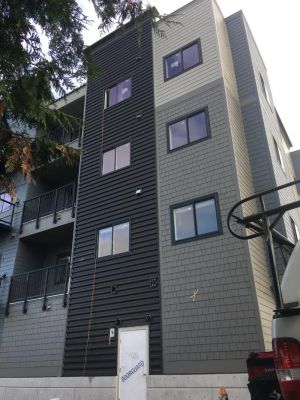Добавете безплатно своя сайт в българската класация Страна Топ 100 и му подсигурете допълнителен трафик и посещения.
В новинарските рубрики
В момента има 39 посетителя в сайта| Siding Job Costs 2025: Complete Pricing Guide and Estimation Methods |
| Сряда, 06 Август 2025г. 08:34ч. | |||||
|
Master siding project pricing with our comprehensive cost breakdown. From material selection to labor estimation, get accurate pricing insights for your next siding project. Complete guide to siding job costs in 2025. Learn how to estimate materials, labor, and total project expenses for residential siding installations and replacements. Understanding siding costs represents one of the most crucial aspects of planning any exterior renovation project. Whether you're a homeowner budgeting for a new installation or a contractor preparing estimates, accurate cost assessment ensures project success and prevents budget overruns. This comprehensive guide breaks down every component of siding job pricing to help you make informed decisions. How Much Should a Siding Job Cost?Siding project costs vary dramatically based on multiple factors, making accurate estimation essential for both planning and budgeting purposes. National Cost Ranges (2025)Complete Siding Installation:
Cost Per Square Foot Breakdown:
Primary Cost FactorsMaterial Selection Impact: The choice between vinyl, fiber cement, wood, or premium materials like natural stone significantly affects total project costs. Material costs typically represent 40-60% of total project expenses. Labor Complexity Variables:
Geographic Location Influence: Labor costs vary significantly by region, with metropolitan areas typically commanding 20-40% higher rates than rural locations. Local building codes and permit costs also impact total expenses. How Much is a Typical Siding Job?Understanding typical siding job costs helps establish realistic budget expectations and identify potential pricing anomalies. Average Project Costs by Home Size1,200 Square Foot Home:
1,500 Square Foot Home:
2,000 Square Foot Home:
2,500 Square Foot Home:
Project Scope VariationsBasic Siding Replacement: Simple material substitution without structural modifications typically falls on the lower end of pricing ranges. This includes standard vinyl-over-wood installations with minimal trim work. Comprehensive Renovation: Projects involving insulation upgrades, structural repairs, complex architectural details, or premium materials command higher pricing but provide enhanced long-term value. Partial Siding Projects: Accent walls, additions, or repairs typically cost $12-18 per square foot due to setup costs and material waste factors affecting smaller projects. How to Estimate Labor Cost for Siding?Accurate labor cost estimation requires understanding both time requirements and local wage rates for skilled siding installation crews. Labor Time CalculationsInstallation Speed Factors:
Time Variables:
Labor Rate StructuresHourly Rate Ranges:
Per Square Foot Labor Pricing:
Labor Cost Calculation MethodsMethod 1: Time-Based Estimation
Method 2: Square Footage Multiplier
Method 3: Percentage of Material Cost Labor typically represents 50-70% of material costs for standard installations, though this varies significantly by material type and project complexity. How Do I Quote a Siding Job?Professional siding quotes require systematic evaluation of all project components to ensure accuracy and profitability. Pre-Quote Site AssessmentMeasurement and Documentation:
Structural Evaluation:
Quote Component BreakdownMaterial Costs:
Labor Components:
Additional Costs:
Quote Presentation StrategiesProfessional Documentation:
Working with experienced Siding contractors ensures accurate project assessment and competitive pricing that reflects both quality workmanship and fair market value for comprehensive siding installations. Competitive Positioning:
How Much Siding for a 1500 Sq Ft House?Calculating siding material requirements involves more than simple square footage multiplication due to architectural features and waste factors. Basic Calculation MethodsWall Area Estimation: For a typical 1,500 sq ft single-story home:
Two-Story Home Adjustments:
Material Quantity CalculationsPrimary Siding Materials:
Trim and Accessories:
Specific Material RequirementsVinyl Siding (1,500 sq ft net area):
Fiber Cement Siding:
Cost Implications by MaterialVinyl Siding System:
Fiber Cement System:
Wood Siding System:
Advanced Cost ConsiderationsHidden Cost FactorsStructural Discoveries:
Code Compliance Upgrades:
Seasonal Pricing VariationsPeak Season Premiums: Spring and summer installations may carry 10-20% premium pricing due to high demand and favorable weather conditions. Off-Season Advantages: Fall and winter scheduling often provides cost savings and better contractor availability, though weather delays may affect timelines. Long-Term Value ConsiderationsInvestment Payback:
Lifecycle Cost Analysis:
Conclusion: Making Informed Siding Investment DecisionsUnderstanding siding job costs empowers both homeowners and contractors to make informed decisions that balance quality, performance, and budget considerations. Accurate cost estimation requires comprehensive evaluation of materials, labor, and project-specific factors that influence total investment requirements. Whether planning a basic siding replacement or comprehensive exterior renovation, thorough cost analysis ensures realistic budget planning and successful project completion. Remember that the lowest bid rarely represents the best long-term value—focus on contractors who provide transparent pricing, quality materials, and professional installation practices. By understanding these cost factors and estimation methods, you're better equipped to evaluate quotes, plan budgets, and achieve successful siding projects that enhance your property's value and performance for years to come. www.unitedseattle.com/siding
|


